This story contains footnotes. The bold numbers refer to correlated footnotes at the bottom of the story.
At 7:57 am on Thanksgiving morning, I parked my green 2011 Subaru Outback on the northern flank of Mount Tabor and went for a stair run. I left my wallet in the glove compartment and my laptop in my backpack on the back seat.
It never occurred to me that they might be imperiled. After all, the houses on the block where I parked are each valued at close to a million dollars.
At 9:15, I walked the block and a half back to where I had parked my car.
It wasn’t there. 1
I circled the block, sure I was misremembering. There were no remnants of a break-in—no tire marks or shattered glass. It was as if my Subaru had been gently airlifted off the ground. 2
The silver-haired owner of the house I parked in front of was trimming her rose bushes. She said she hadn’t seen anything in the hour she’d been outside.
She offered me tea and a blanket as I sat on the sidewalk.
I called the city’s non-emergency line.
A police officer called back and filled out a police report over the phone. He explained the process: My car would enter a database of stolen cars. If an officer comes across a suspicious-looking vehicle, they scan the vehicle identification number to see if it matches one in the database.
If it’s reported abandoned to the Portland Bureau of Transportation, the agency can tow it to an impound lot. Or, if it’s illegally parked on private property, the owners of the property can have it towed independent of any city agency. 3
I asked family and friends to spend their Thanksgiving morning driving around Portland in search of my Subaru. It was, after all, just 145 square miles of city to cover. We hit spots known by most Portlanders as places where clusters of dismembered cars are parked on or beside the road. 4 My sister went to Delta Park. My sister’s friend Dylan drove along Marine Drive. My mom went up to Airport Way.
My dad and I set off to an Argay neighborhood chop shop where cops had recovered 11 vehicles a month prior. 5
The camp, set up along an 800-foot stretch of muddy ground, was tucked behind a warehouse. A man at the entrance of the camp was sharpening a large knife. I said hi and explained why we were there.
We trudged down the foot-deep trench of mud, crisscrossing the mire in search of drier spots. My dad trailed behind me, in socks and slides, ankle-deep in mud.
There were about eight vehicles in various stages of disassembly. Two men leaning on a white truck watched us as we came down the path. I said hello and that we were looking for my Subaru. They shrugged.
As we left, the man with the knife said to look in the alley behind the 7-Eleven.
On the way to the 7-Eleven, I got cellphone alerts that my debit card had bounced two charges, each over $200, at the Gateway Fred Meyer. We headed there, unsure of what we’d do if we found my car. 6
I called the cop who had taken my police report to tell him. He seemed unmoved.
We circled the parking lot with no luck. My sister asked Fred Meyer security to check their security camera footage. (A week later, a corporate representative for Fred Meyer told me only law enforcement was allowed to review footage.)
For the next four hours, we drove at a snail’s pace around the area, scouring dead-end streets, residential neighborhoods, and apartment parking lots. 7 When we saw a particularly promising spot, we would slow down and I’d hold my key fob in the chilly wind, pressing the alarm button, my fingers looking redder and chubbier every time.
Several times, we passed a man and woman in their 30s and a young boy who seemed probably 7, leaning against the hatch of a car packed with clothes and duffels. It was sobering. Their car was home and they’d be spending Thanksgiving outside.
On Saturday morning, two days later, I got a call from the Portland Police Bureau. My car had been towed by 21st Century Towing at 6 am to one of its impound lots.
The Police Bureau said it was found illegally parked in an apartment complex. The tow employee offered the address: Stark Street Villa, a green and beige low-income apartment complex.
The tow lot was hidden behind a rickety metal fence. It was a small, muddy lot packed with cars with shattered windows, ripped-off rearview mirrors, and front ends truncated by collisions.
I paid the tow fee—$266—and the man pushed open the gate, signaling me to leave. I asked my friends if my car would explode if the catalytic converter had been stolen. They told me no. The ignition was partially punched in—a little sticky, but it worked. I drove out of the muddy lot. The catalytic converter was intact. 8
Juice and Nesquik chocolate milk bottles littered the Subaru’s floor. Personal items like work notes scribbled on stray pieces of paper and grocery receipts from my console were scattered about. Two slices of pepperoni pizza from 7-Eleven sat uneaten on the dash.
They had ripped off the rear license plate, disabled the alarm system, and scraped off my Bernie Sanders bumper sticker. 9
They had left a hooked iron tool in the passenger seat that curved gently on one end. This tool appeared to have been used to pry open the window so the door lock could be jimmied with another tool. A little leather strap was attached for easy carrying. It looked well worn.
The wasteland in my car didn’t have a feeling of desperation—it felt like chaotic, messy fun. It seemed like the work of kids. 10
My backpack with the laptop and my wallet were gone, as were letters I’d kept for the past seven years, ones I had no intention of anyone ever reading. They had left my basketball and tennis rackets.
As unsettled as I was that they knew what I looked like and where I lived and who had written me letters, I found myself wondering about their impression of me based on the contents of my car. Did they think I was a sporty gal? 11
After having my car stolen, I do not think Portland is a lawless city, or a lost cause. It does not make me fearful to walk when I want and where I want.
I do get a pang of anxiety every time I walk out to the car now, sure it will be gone with no trace, but I keep telling myself: It’s just probability, baby. If not my car, it would’ve been the next Subaru on the street. If my personal items weren’t rifled through, it would’ve been someone else’s.
Strangely enough, having my car stolen made me feel, at least for half a day, more connected to a city that is hurting, far from the general ease of my life. That day, I paid careful attention to things I would not have before, like how the potholed streets get worse the farther east you go, or the especially wide and lonely streets along Airport Way, or the boy who spent maybe his first Thanksgiving outside, in a car that doubled as his home.

Footnote 1
In September, 903 vehicles were reported stolen in Portland. In October, that number rose to 1,031. And November? 1,140. That’s the highest monthly total since the Portland Police Bureau started logging and publishing car theft data in 2015, and double the monthly average in 2019. So far this year, 8,024 cars have been stolen in Portland. That’s almost 1,500 more than were stolen in the same time frame in 2017, when car thefts rose to historic levels, and it’s the highest number since 1997.
Footnote 2
The Subaru Outback is tied as the fourth-most stolen vehicle in Portland, police say, right after three popular models of Honda. My car was stolen in Montavilla, the fifth-most targeted neighborhood for car thefts, and was dropped off in the Hazelwood neighborhood—the most targeted. But my car was stolen at the least likely time of day. Less than 15% of cars are stolen between 6 am and noon; 40% to 45% are stolen between 6 pm and midnight. My car is also newer than most that are stolen; the sweet spot is 1995-2006 models.
Footnote 3
PPB says it recovers 78% of stolen cars within 30 days, and 89% of cars reported stolen this year have been recovered to date. But after a car is recovered, Police Bureau spokesman Sgt. Kevin Allen says, police usually close the case because there are no leads—or only leads they consider too time-consuming to pursue and investigate. “We just don’t have the bodies to do that right now,” Allen says. “It’s fair to say that officers are rarely able to spend time on those investigations.”
Footnote 4
In 2019, two years after WW reported a loophole in car theft laws that allowed repeat thieves to avoid prosecution (“Car Jack City,” Nov. 29, 2017), lawmakers tried to close the loophole. Prior to 2019, if someone was found behind the wheel of a stolen car, they could easily avoid arrest simply by claiming they didn’t know it was stolen. The 2019 law allowed more evidence to be used to bring cases against car thieves.
Kevin Demer, a senior deputy district attorney for Multnomah County, says the 2019 law “did move the nail, but it didn’t put the pedal to the metal.” WW reported in 2017 that repeat offenders often knew what to say to evade arrest and prosecution. But Demer says thieves have developed a new script: “Criminals are smart, so they know other things to say.” The DA’s office says police referred 1,192 auto theft cases this year, and prosecutors pursued 61% of them. Demer says its ability to prosecute is incumbent upon police investigating the thefts. “We’re the catcher,” Demer says. “The police are the pitcher.”
Footnote 5
The last time the Portland Police Bureau had an auto theft unit was in 2006, before it was disbanded due to budget cuts. Today, the bureau has zero detectives or officers dedicated to auto theft, leaving patrol officers to recover cars if they come across them. But bureau spokesman Sgt. Kevin Allen says an officer investigating a stolen car case is “exceedingly rare.” Officers don’t have time to fully investigate car thefts, he says. “There aren’t a lot of leads, frankly.”
PPB provided raw car theft arrest figures since 2018, with the caveat that the data does not account for possible duplicates or omissions. So far in 2021, 861 arrests have been made for unauthorized use of a motor vehicle. That represents about 11% of the cars stolen through November of this year. Last year, there were 702 arrests. In 2019, 717. In 2018, 680. In other words, arrests appear to be trending upward—but it’s still fewer arrests in a year than cars stolen in a month.
Allen says focused teams have helped to significantly knock down certain crimes in the past. When asked if there’s merit to creating such a unit to dissuade car thieves for a dedicated period of several years, Allen says the bureau doesn’t want to make promises it can’t keep: “The true question is, where do you take those resources from? Rape? Robbery? Homicides?”
Footnote 6
Police say most car thefts are connected to drug use, evident from drug paraphernalia often left in cars. “Folks who are addicted or living or involved in drug use seem to be a lot of times involved in this,” Allen says. “Usually it’s meth and a lot of heroin.” Demer, the prosecutor, says most cases he sees involve someone suffering from addiction. When asked if he thinks car theft is connected to addiction, he says, “Of course it is.”
Footnote 7
Even as police concede they can’t keep up with auto thefts, some citizens are trying. On the social media site Nextdoor, there’s a frequently posted collaborative spreadsheet of 52 chop shops and stolen car dumps across the city. I had visited six of these already. Most were homeless camps or adjacent to one. Facebook groups with membership in the thousands allow Portlanders to post details about their stolen cars.
Footnote 8
A wave of catalytic converter thefts has struck Portland in the past two years, thanks to the high resale value of rhodium, platinum and palladium found in the devices. National reports estimate catalytic converter thefts have risen by nearly 300% over the past year. Manheim Auto Auction in North Portland had almost 20 catalytic converters stolen from cars on its lot this summer. Catalytic converters from 19 buses and three other vehicles were stolen in a single night in September from the bus yard for the Reynolds School District. Vision Auto in Mount Tabor had 10 catalytic converters stolen over the course of the summer.
Danny Trung, owner of Danny’s Auto Repair in the Roseway neighborhood, says thieves have hacksawed portions of his metal fence four times this year to steal catalytic converters from his lot. “Last week, they jumped over my fence and just chopped it up. I ran up here and called the police, and they didn’t show up,” Trung says, who’s taken to sleeping upstairs in the shop so he can drive thieves away. “I carry concealed. I told the cops, ‘If you guys don’t come, I’ll do it myself.’”
A law goes into effect next year in Oregon aimed at curbing catalytic converter thefts. The law makes it illegal for scrap metal shops to buy converters from anyone besides the owner of the vehicle or a commercial seller.
Footnote 9
Repair shops now offer a new product in high demand: catalytic converter shields to protect against theft. Installation costs $300 to $400. Cale Pelton, a manager at Atomic Auto in the Hazelwood neighborhood, says his shop started offering shield installations in 2020 and have put in over 1,000 since then—more than 600 so far this year. And customers coming in after their catalytic converters were stolen jumped 40% this year from last year, Pelton says. “It’s another source of revenue we weren’t expecting, but it’s an unfortunate line of revenue.”
Footnote 10
The Police Bureau hesitates to divulge themes that have emerged from the spike in car thefts, largely because many are anecdotal. But Allen says it’s evident in a portion of thefts that thieves aren’t simply trying to make money from car parts: “A lot of times, the theft has nothing to do with a plan to strip or sell parts. A lot of times, it’s just for a ride. People will steal a car, use it to ride somewhere, use it to commit another crime, and then dump it.” It’s called “joyriding.”
Footnote 11
The FBI keeps car theft stats for each state. Little can be gleaned about car thieves from such data since arrests are not often made. But we do know a few things about the small portion of Oregon thefts that the FBI has data on: Adults aged 20-29 are the demographic most likely to steal cars, with 30-39 close behind. Thieves are also overwhelmingly male and white. Just 9% of auto thefts in the FBI data were committed by kids between the ages of 10 and 19.

